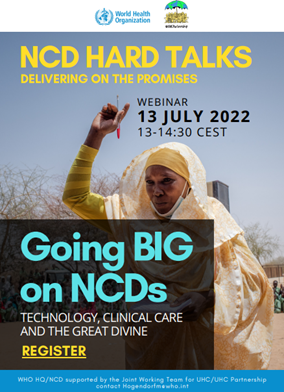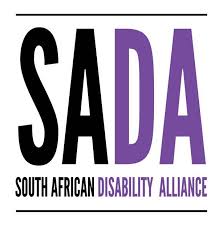
NCD Hard Talk_13 July_flyer
We are pleased to invite you to the next NCD Hard Talk webinar taking place on Wednesday, 13 July 2022, 13:00 – 14:30 CEST titled “Going BIG on NCDs: Technology, Clinical Care and the Great Divine.”
Profound and urgent changes are required to respond to the accelerating NCD burden, and a global shake-up is needed to reimagine the possibilities – and invent solutions fit for this new era. The recently established Global Group of Heads of State and Government on NCD provides an opportunity to engage the highest authorities on these BIG NCD solutions.
In this NCD Hard Talk session, we explore three examples of distinct, cutting-edge visions that can radically impact NCD outcomes, including:
- Medicines: technology transfer for local production of insulin and NCD medicines to increase access
- Acute care: strengthening immediate care for saving lives
- Community: leveraging faith-based authority for NCD prevention and control
Join us on Wednesday by registering here: https://who.zoom.us/webinar/register/WN_aAPSps-cRduO26HOaI4bYA
lo.

InAble is holding its 3rd Annual Inclusive Africa Conference
Register here. https://us02web.zoom.us/webinar/register/WN_BfmPpGbPQq6hy0vB5XmwrQ
Keynote speakers include
- Haben Girma, a disability rights advocate;
- Jenny Lay-Flurrie, Chief Accessibility Officer, Microsoft,
- Cobhams Asuquo, Music Producer & Performing artist .
Hosted by inABLE, the program highlights include the launch of the first-ever ICT Accessibility Standard in Africa and Google Digital Accessibility Innovations Award. Here is a programme
The conference is sponsored by The Mastercard Foundation, Google, Microsoft, and Meta.
Summary: 1st WHO essential diagnostic list focusing on mainly communicable diseases with a recommendation to include more NCDs in a future edition. PHC and facility level essential package. Vicki Pinkney-Atkinson
Improving NCDs diagnosis & treatment outcomes
Today, many people are unable to get tested for diseases because they cannot access diagnostic services. Many are incorrectly diagnosed. As a result, they do not receive the treatment they need and, in some cases, may actually receive the wrong treatment.
For example, an estimated 46% of adults with Type 2 diabetes worldwide are undiagnosed, risking serious health complications and higher health costs. Late diagnosis of infectious diseases such as HIV and TB increases the risk of spread and makes them more difficult to treat.
Essential Diagnostics List (EDL)
To address this gap, WHO today published its first Essential Diagnostics List (EDL), a catalogue of the tests needed to diagnose the most common conditions as well as a number of global priority diseases.
“An accurate diagnosis is the first step to getting effective treatment ….No one should suffer or die because of a lack of diagnostic services, or because the right tests were not available.”
Dr Tedros Adhanom Ghebreyesus, WHO Director-General.
The list concentrates on in vitro tests – i.e. tests of human specimens like blood and urine. It contains 113 products: 58 tests are listed for detection and diagnosis of a wide range of common conditions, providing an essential package that can form the basis for screening and management of patients. The remaining 55 tests are designed for the detection, diagnosis and monitoring of “priority” diseases such as HIV, TB, malaria, hepatitis B and C, human papillomavirus and syphilis.
Some of the tests are particularly suitable for PHC facilities, where laboratory services are often poorly resourced and sometimes non-existent; for example, tests that can rapidly diagnose a child for acute malaria or glucometers to test diabetes. These tests do not require electricity or trained personnel. Other tests are more sophisticated and therefore intended for larger medical facilities.
“Our aim is to provide a tool that can be useful to all countries, to test and treat better, but also to use health funds more efficiently by concentrating on the truly essential tests,” says Mariângela Simão, WHO Assistant Director-General for Access to Medicines, Vaccines and Pharmaceuticals. “Our other goal is to signal to countries and developers that the tests in the list must be of good quality, safe and affordable.”
For each category of test, the EDL specifies the type of test and intended use, format, and if appropriate for primary health care or for health facilities with laboratories. The list also provides links to WHO Guidelines or publications and, when available, to prequalified products.
Similar to the WHO Essential Medicines List, which has been in use for four decades, the EDL is intended to serve as a reference for countries to update or develop their own list of essential diagnostics. In order to truly benefit patients, national governments will need to ensure appropriate and quality-assured supplies, training of healthcare workers and safe use. To that end, WHO will provide support to countries as they adapt the list to the local context.
The EDL was developed following an extensive consultation within WHO and externally. The draft list was then considered for review by WHO’s Strategic Advisory Group of Experts on In-Vitro Diagnostics – a group of 19 experts with global representation. For more information see WHO website.
WHO will update the Essential Diagnostics List on a regular basis. In the coming months, WHO will issue a call for applications to add categories to the next edition. The list will expand significantly over the next few years, as it incorporates other important areas including antimicrobial resistance, emerging pathogens, neglected tropical diseases and additional NCDs.


